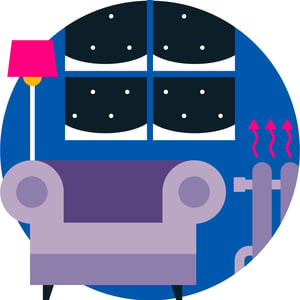Make Your Home Energy Efficient Before the Cold Sets In
As the days get shorter and colder, your home energy use will start to creep higher. Now the clocks have gone back but before winter descends, take the time to ensure your home is as energy efficient as possible. Not only will it save you money on your rising energy bill and reduce your impact on the environment, but you’ll create a cosier bolthole to escape the worst of the weather.
Here are some simple, but effective measures to start with.
Up to 30% of the average electricity usage could be Phantom Load - do something about it! Get more from your smart meter with Loop.
Be Smart With Your Lighting
Darker days mean higher lighting costs - lighting accounts for around 11% of a typical household's energy bills, so there are some big savings to be made by swapping incandescent and halogen bulbs with super-efficient LEDs. You could save around £45 by swapping your old halogens to LEDs! Don't wait until your old bulbs break. Make the swap now and enjoy the savings all winter long.
Check the Boiler
If you have an old boiler, you may approach the cold months with a lingering fear that it will give up the ghost at any moment. So be sure to plan ahead and have your boiler serviced by a qualified engineer.
Have you got a combi boiler?
If you do, you can save money just by lowering your boiler's flow temperature. Most boilers are designed to send water to your radiators at temperatures under 60°C, but they’re often not configured this way. Making this one simple setting change could save 12% on your gas bill - all without reducing the temperature of your home!
Is it time to upgrade your heating?
While heat pumps are gaining traction, they aren't for everyone yet. If your boiler is over 10 years old, it could be costing you more than you think. Save up to £420 per year by upgrading to a high-efficiency gas boiler with full heating controls. We’ve partnered with Heatable to offer Loop users a £50 discount on new boilers. Simply sign up to Loop for FREE to claim yours.

Insulate Pipes
You may have never given your hot water pipes much thought. But it’s important - and easy - to keep them insulated to reduce heat loss. You just need to buy some foam lagging to wrap around pipes, which you can easily fit yourself.
Depending on the size of your house, you’ll probably only need to spend £20 or so on lagging, which you’ll soon make back. Lagging also reduces the chances of pipes getting too cold and bursting.
Draught-Proof Your House
You want to keep hold of that precious warmth in your home and block its escape. That means draught-proofing windows, doors, floorboards, loft hatches, and any other gaps. The exceptions are rooms like bathrooms that need ventilation.
If you need to hire a professional to draught-proof your home, it’s worth the effort as it could save you around £85 a year on your energy bill. You’ll create a cosier, more comfortable home too.
Alternatively, if you’ve got most parts of your house draught-proofed, consider any gaps you might have missed. How about fitting keyhole or letterbox covers?
Chimneys
Lovely as it is to sit in front of an open fire, they’re not very energy efficient, as most of the heat just goes straight up the chimney - as much as 90%!
If you’re after a more energy-efficient home that has less of an impact on the environment, then it's best to stick to using your central heating efficiently. And, if that leaves you with an open fireplace that you’re not using, then consider insulating it to prevent too much cold air from coming into your home.
Curtains
Simply open your curtains when the sun is shining - yes, even in winter - to allow in as much warming sunlight as possible. Then close them in the evening. Similarly, close doors to stop draughts. This might not make the biggest saving on your energy bill, but it's a good practice step to improve efficiency. Every little adds up!
Radiators
Your radiators need a bit of annual TLC. Bleed them to ensure that hot water can circulate effectively. You’ll know a radiator needs bleeding if it feels hot at the bottom but cold at the top, takes a long time to warm up, or if it’s making gurgling noises.
Also, pull any sofas away from radiators. Otherwise, your sofa will absorb the heat instead of circulating properly!

Control Your Heat
As it gets colder, you’ll want the heating on more often. But, don’t just whack the thermostat up into the mid-20s. Each degree you turn down your central heating thermostat equates to a 10% reduction in gas use.
To better manage the temperature of your home, consider investing in a smart thermostat or smart radiator valves. They'll enable you to control your heating remotely and target the heat to the rooms you use the most.
Reduce Your Phantom Load
With all the other demands on your home energy in the colder months of the year, you certainly don’t want to waste money on things you’re not using. But did you know, 30% of the average electricity usage is wasted energy?
So, tackle your Phantom Load, the energy used by your things left on or on standby. While appliances like fridges and freezers must stay on all the time, in most rooms you'll probably have at least one device that's quietly continuing to drain electricity in the background - whether you're aware of it or not! So have a quick dash around your home turning things off at the plug. You'll be amazed at how much you could save!
• • •
Cut Your Energy Bill With Loop
Loop is a FREE energy-saving app that links to your smart meter, analyses your energy use and shows you easy ways to save. On average, Loop users cut their energy use by 15%! How much could you save?








